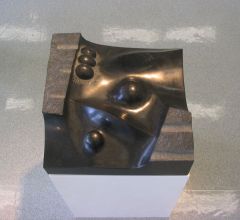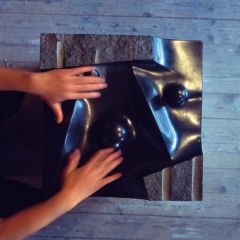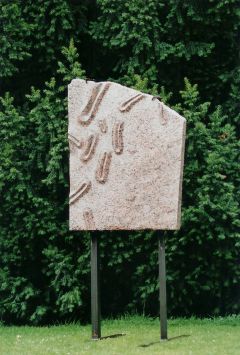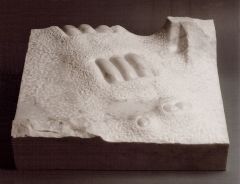| |


|
> A part of your work of sculpture
is frontal and graphic. Can we definite those sculptures
by the word “texture” ?
_ You can’t limit my work to just texture. The vibration
of the material makes the sculpture alive and ready for
my hands and the hands of the public. I love to do this
surface work, rich in contrasts: raw, polished, pricked,
and flamed...
> In your work there are horizontal
textures that we dare touch and some vertical that we
don’t, why ?
_ People are invited to touch !
When it is on the ground we can walk on it, its position
is an authorisation in itself.
When it is vertical, you really have to make an effort
to go towards the sculpture. Sometimes it must also be
a matter of the density of information available.
> I am surprised, you have a very naturalistic explanation,
I expected a more cultural or educational answer: a work
presented vertically looks like a canvas or calligraphy,
you can’t touch it, it’s even forbidden.
_ That is probably the reaction of an audience which is
locked up in a certain mindset.
> Do you sculpt with your
eyes closed ?
_ Yes, sculpture is a question of volume, I look a lot
with my hands, although if can get a little risky when
using a hammer!
|


|
> あなたの彫刻の仕事の一部は正面性が強く、図形的です。これらの作品は「テクスチャー」を主題にしたものと言って良いものですか
?
_「テクスチャー」という言葉に限ることはできません。素材の持つ波動が、私やパブリックの手が触れる時、彫刻に生を与えるのです。私はざらざらしていたり、磨き上げられたり、のみ切りされたり、バーナー仕上げされた、コントラストに富んだ表面の仕事が好きです。
> あなたの作品の中には、見る人がさわりたくなるような水平の表面と、触るには抵抗を感じる垂直の表面がありますが、何故でしょうか
?
_ 見る人には触ってもらいたいと思っています。作品が水平の位置だったり、特に敷石のような場合は自然に上を歩くことができるという様に接触が許されています。縦ですとどうしても彫刻のある場所へ近づかなければならない訳です。それに時には正面性の作品は見る人に説明的に感じられるのかもしれません。
> 驚きですね。とても自然主義的な回答と思いますが、私はもっと文化的であるかとか教育的な答えを予想していました。
_ 縦に展示される作品は、時には絵画の様に、または書道のように見え、それにはさわらない、さわってはいけないと言う習慣になっています。
それはあまりにも型にはまった人たちの反応と思います。
> 目を閉じて彫ることはありますか
?
_ はい、彫刻はヴォリュームですから。手でよく作品を見る事があります。でもハンマーを使うから、それはちょっと危ないですね
! (笑い)
> Une partie de ton travail de
sculpture est frontale, graphique. Peut-on définir
ces travaux par le terme «texture» ?
_On ne peut pas se limiter au terme texture. C’est la vibration
de la matière qui rend la sculpture vivante par le toucher,
pour mes mains et celles du public. J’aime faire ce travail
de surface, riche en contrastes: brute, polie, piquetée,
flammée, etc.
> Dans ton travail il y a des
surfaces sculptées horizontales qu’on ose toucher,
et des surfaces sculptées verticales que l’on n’ose pas
toucher, pourquoi ?
_ Les gens sont invités à toucher ! Quand c’est au sol,
on peut marcher dessus, on est déjà autorisé. Quand c’est
vertical, il faut faire l’effort d’aller vers la sculpture.
Parfois il doit s’agir d’une question de densité d’informations.
> C’est étonnant, tu as une réponse très naturaliste,
je m’attendais à une explication beaucoup plus culturelle,
une question d’éducation: présentée verticalement ça
ressemble à un tableau ou une calligraphie, on ne touche pas, c’est
même interdit.
_ C’est probablement la réaction d’un public trop conditionné.
> Tu
sculptes les yeux fermés ?
_ Oui la sculpture c’est le volume, je regarde beaucoup
avec les mains, mais c’est un peu risqué avec le marteau
... ! (rires)
|
|
|
|
|
|
|